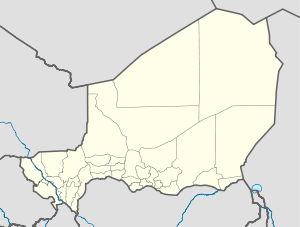Arbre du Ténéré
| Arbre du Ténéré | ||
|---|---|---|
|
|
||
| place | Ténéré desert | |
| region | Agadez , Niger | |
| Tree species | Umbrella acacia ( Vachellia tortilis ) | |
| Geographical location | 17 ° 44 '42 " N , 10 ° 4' 51" E | |
|
|
||
The Arbre du Ténéré ( French: "Tree of Ténéré") is an important landmark in the southwest of the Ténéré desert in Niger . At the Arbre du Ténéré, the piste from Agadez divides : over the fountain from Achegour to Dirkou and further south over the Fachi oasis to Bilma in the Kaouar Valley .
history
Originally the Arbre du Ténéré was an umbrella acacia , which was considered to be the most isolated tree on earth - allegedly the only one within a radius of 400 kilometers, other information cites 150 km. It was probably the last surviving tree in a group of trees that grew when the desert was less arid than it is now. The tree stood alone for several decades. During the winter of 1938/39 a shaft was dug near the tree, and it became apparent that the tree had reached the water table at a depth of 33 to 36 meters. In 1939, officer Michel Lesourd, stationed in French West Africa , wrote of the lonely tree:
«The faut voir l'arbre pour croire à son existence. Quel est son secret? Comment peut-il être toujours en vie malgré la multitude de dromadaires qui dévastent les alentours? Comment se fait-il qu'à chaque Azalai, aucun chameau ne dévore ses feuilles ou ses bourgeons? Parmi les nombreux Touaregs qui conduisent les caravanes de sels, pourquoi donc aucun d'eux ne lui coupe les branches pour faire du feu pour le thé? La seule réponse est que cet arbre est tabou et qu'il est considéré comme tel par les caravaniers. »
“You have to see the tree to believe its existence. What is its secret? How can he still remain indestructible despite the multitude of dromedaries around him? How is it that no camel eats its leaves and buds? Why do n't the Tuareg's many salt caravans cut off its branches and use them as firewood for making tea? The only answer to this is that this tree is taboo and is so respected by caravans. "
As early as 1959, when comparing photos from 1939, travelers noticed that the branches of the tree had clearly decreased and the foliage had thinned. The tree had apparently been damaged in a collision with a motor vehicle.
The acacia was knocked over in 1973 by an allegedly drunk truck driver. The destruction of the tree was discovered in November 1973 by participants in the Raid Afrique rally organized by Citroën . The then lieutenant and later President Ali Saibou brought the remains of the Arbre du Ténéré on November 8, 1973 in a military transporter to Niamey in the Nigerien National Museum , where they have been exhibited in a separate pavilion since 1977.
At its original location, the acacia was replaced by a tree-like structure made of metal tubes, later on whose “branches” chrome-plated hubcaps were attached as reflectors for night drivers. In 1998 Katsuyuki Shinohara erected the metal sculpture "Lighthouse of the Desert", with glass elements as optical and wind harps as acoustic orientation signs.
There is a well at the Arbre du Ténéré, but the water is of poor quality, possibly from a fallen carcass. This place serves as a night camp for the salt caravans . The nomads' camp near the well is called Ad Azzaouagger.
See also
- Shajarat al-Haya - a similar tree in the desert of Bahrain
literature
|
Web links
L'Arbre du Ténéré: son histoire
Individual evidence
- ↑ L'Arbre du Ténéré: son histoire | Le Saharians. Retrieved January 12, 2020 .
- ↑ a b L'arbre du Ténéré, symbols de la survie dans le Sahara. (No longer available online.) Archived from the original on January 4, 2014 ; Retrieved December 13, 2015 (French). Info: The archive link was inserted automatically and has not yet been checked. Please check the original and archive link according to the instructions and then remove this notice.
- ↑ Abdourahmane Idrissa, Samuel Decalo: Historical Dictionary of Niger . 4th edition. Scarecrow, Plymouth 2012, ISBN 978-0-8108-6094-0 , pp. xxxiii .
- ↑ L'Arbre du Ténéré- (2). Archived from the original on March 2, 2009 ; accessed on December 13, 2015 .
- ↑ L'Arbre du Ténéré: son histoire | Le Saharians. Retrieved January 12, 2020 .



